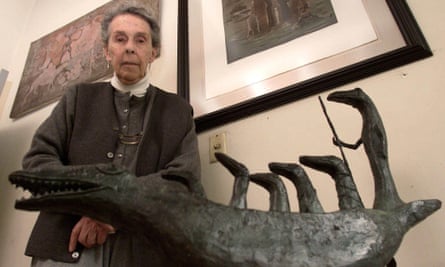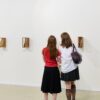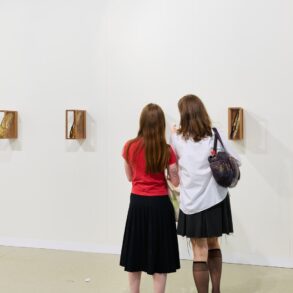She was worshipped as a muse by renowned surrealists including André Breton and Max Ernst, but the Lancashire-born artist Leonora Carrington quickly shrugged off the label to achieve an unprecedented level of mastery and freedom in her own painting.
Now, on the 100th anniversary of Breton’s publication of the Surrealist Manifesto, Carrington has become the most valuable British-born female artist at auction after one of her paintings sold for more than £22.5m.
Les Distractions de Dagobert sold at Sotheby’s in New York after a 10-minute bidding battle to the Argentine businessman Eduardo Costantini, the founder of the Museum of Latin American Art of Buenos Aires (Malba).
The painting is widely recognised as the defining masterpiece of Carrington’s career, showcasing rich surreal imagery and luminous colour on a large scale. Julian Dawes, Sotheby’s head of impressionist and modern art in New York, called it “the definitive masterpiece of Leonora Carrington’s long and storied career, bearing all the hallmarks of the artist at her absolute height”.
The work’s title is a reference to Dagobert, a Merovingian king who ruled Gaul in the early seventh century, popularly remembered as a king whose taste for sexual excess was matched by a love of luxury.
Sotheby’s describes the painting as a tapestry of meticulously crafted vignettes corresponding to the four elements: earth, air, fire and water. The scenes vary from ghostly extinct volcanoes to a watery world where a giant with a double animal head holds a human-faced puffer fish.
“An iconic painting, The Distractions of Dagobert is one of the most admired works in the history of surrealism and an unparalleled masterpiece of Latin American art,” said Costantini, after the sale. “This masterpiece will be part of a collection where, amongst others, two important works by [the Spanish surrealist painter] Remedios Varo and another record-breaking Frida Kahlo are also found.”

Carrington’s visual language was first formed when she discovered the surrealist movement at the International Surrealist Exhibition in London in 1936. Here, she found kindred artistic spirits in Breton, Salvador Dalí, Man Ray and Ernst, who like her were fascinated by dreams, the subconscious and the occult.
She and Ernst went on to form a romantic relationship and travelled to France, where their circle included Pablo Picasso, Dalí, Joan Miró, Breton, Leonor Fini and Marcel Duchamp. However, their relationship soon turned tumultuous, marked by Ernst’s imprisonment at the outbreak of the second world war, and resulting in Carrington’s institutionalisation in Spain in 1940.
after newsletter promotion
Les Distractions de Dagobert was painted in 1945, two years after Carrington moved to Mexico and joined a community of “exiled” surrealists including Varo, Wolfgang Paalen and Alice Rahon, as well as modern Mexican painters such as Kahlo and Diego Rivera.
Gabriel Weisz Carrington, Leonora’s son and a professor of comparative literature at the National Autonomous University of Mexico, said Carrington’s works “developed a very personal interpretation of surrealism, influenced by her motherhood”. He said the artist, who died in 2011 aged 94, had given “birth to her creations”.
Wednesday’s auction follows an increased interest in the long-overlooked female artists associated with the surrealist movement. In recent years they have been honoured by museum exhibitions around the world including the recent Surrealism and Magic: Enchanted Modernity at the Peggy Guggenheim Collection in Venice, where this painting was a centrepiece.
Female artists associated with the movement have achieved increasingly high prices at auction in recent years – in 2021, Kahlo’s Diego y yo fetched a record-breaking $34.9m at Sotheby’s in New York, the highest price ever for a Latin American artist, and the second highest price achieved at auction for a female artist.
Allegra Bettini, the head of Sotheby’s modern art evening auction in New York, said: “The recent surge of interest in previously overlooked women artists connected with the surrealist movement marks a profoundly significant cultural shift.”
This post was originally published on this site be sure to check out more of their content







